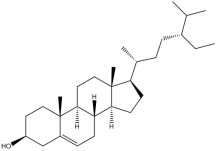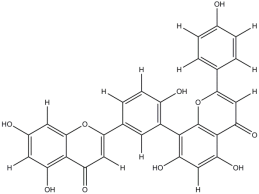A Biflavone and a Plant Sterol Isolated from Antidesma bunius (Linn.) Spreng.
Ivan L. Lawagai,* Suad Naheedb, Mohammed Mosihuzzamanc, Allan, Patrick G. Macabeoadeg, Erickson Paragasefk, Peter Prokschh, Alicia M. Aguinaldoaeg
Keywords: Antidesma, Antidesma bunius, Amentoflavone, Betasitosterol, biflavone, sterols
1. Subject and source
Antidesma bunius (Linn.) Spreng. (Euphrbiaceae) ‘‘bignay” is a common plant found throughout the Philippines. The bark is poisonous as it contains an alkaloid thus, is used medicinally. The leaves are acidic and diaphoretic, and, when young, these are boiled with pot-herbs, and employed by the natives in syphilitic infections (Quisumbing, 1978). The leaves are sudorific and are employed in treating snakebite in Asia (Morton, 1987). The leaves of Antidesma bunius, commonly known as “bignay”, are traditionally used by native Filipinos to control diabetes (Lawag et al., 2012).
Fresh leaves were collected from the hills of Brgy. Agustin Navarra, Ivisan, Capiz Province in January 2009. The plant was identified by Asst. Prof. Rosie A. Madulid and a voucher specimen (USTH 5357) is deposited at the UST Herbarium, Botany Laboratory, Research Center for the Natural and Applied Sciences, University of Santo Tomas (UST), Manila, Philippines.
2. Previous work
Dammara-20, 24-dien-3β-ol and friedelin were isolated from the stem and leaves of A. bunius (Hui and Sung, 1968). In 2008, Samappito and Butkhup identified the flavonoids catechin, Procyanidin B1 and Procyanidin B2 from the fruits and Gallic acid, quercetin, catechin and epicatechin were also detected from the fruits of A. bunius (Santiago et al., 2005).
3. Present study
3.1. Extraction and isolation
Dried and ground leaves Antidesma bunius (1610 g) were extracted with 80% ethanol to give a green syrupy extract (240.0 g) which was subjected to vacuum liquid chromatography (VLC) using solvents of increasing polarity starting with hexane, hexane-dichloromethane (1:1), dichloromethane, dichloromethane -ethyl acetate (1:1), ethyl acetate, ethyl acetate-methanol (1:1), and methanol to give seven fractions. The fifth fraction (4.04 g) was further fractionated twice on silica gel packed on VLC using solvents of increasing polarity starting from hexane and ending with methanol giving five fractions each, respectively. Fraction three which was purified twice on silica gel using hexane-dichloromethane (1:1) and hexane-dichloromethane (95:5) furnished 1 (16.13 mg).
Isolation of 2: the fourth fraction (12.34 g) after VLC was chromatographed on silica gel using 5-10% gradients of methanol in dichloromethane to give ten fractions. Fraction three (42.3 mg) was further purified using Sephadex LH20 using 20% gradients of methanol in DCM to give 2 (5.9 mg).


(1)(2)
3.2. Identification of purified compounds
The compounds were identified as Stigmast-5-en-3β-ol or β-sitosterol, a plant sterol, (1) (Balamurugan et al., 2012) and (Sosinska, et al., 2013) and 3′,8”-biapigenin (Amentoflavone), a biflavone (2) (Chari et al., 1977) and (Ryu et al., 2010) on the basis of their IR, LR-EIMS, LR-ESIMS and NMR (1H NMR, 13C NMR, 1H-1H COSY, HMBC and HSQC) spectral data and by comparison of spectra reports with the literature.
4. Chemotaxonomic significance
Other Antidesma species like A. menasu (Risvi et al., 1980a), (Risvi et al., 1980b) and A. pentandrum (Chen et al., 2004), (Kikuchi, 1983) are known to contain plant sterols. A. puncticulatum is known to contain flavonoids (Nuengchamnong and Ingkaninan, 2009), while A. laciniatum was reported to contain both plant sterols and flavonoids (Tchinda et al., 2006).
The isolation process that was presently preformed on the ethanolic leaf extract of A. bunius afforded compounds 1 and 2 which were coherent to the compounds that were previously isolated or reported from the other Antidesma species. Although the said compounds were reported for the very first time in A. bunius, compound 1 was also reported to be present in A. pentandrum (Chen et al., 2004) and in A. laciniatum (Tchinda et al., 2006), while compound 2 was reported to be present in A. laciniatum (Tchinda et al., 2006). This further establishes the chemotaxonomic relationship of A. bunius towards the other species of the genus Antidesma.
Get Help With Your Essay
If you need assistance with writing your essay, our professional essay writing service is here to help!
Although plant sterols (Hui and Sung, 1968) and biflavones (Samappito and Butkhup, 2008), (Santiago et al., 2005) were previously reported in the leaf and bark extracts A. bunius, this is the first report that indicated the presence of β-sitosterol (1) and Amentoflavone (2). Compounds 1 and 2 therefore add up to the list of isolated and identified compounds from the leaves of A. bunius.
References
Quisumbing, E., 1978. Medicinal Plants of the Philippines. Katha Publishing Inc., Quezon City, Philippines.
Balamurugan, R., Stalin, A. and Ignacimuthu, S., 2012. European Journal of Medicinal Chemistry 47, 38 – 43.
Chari, V. M., Ilyas, M., Wagner, H., Neszmelyi, A., Chen, F., Chen, L., Lin, Y., Lin, Y., 1977. Phytochemistry 16, 1273 – 1278.
Chen, Y.C.; Cheng, M.J.; Lee, S.J.; Dixit, A.K., Ishikawa, T., Tsai, I.L.; Chen, I.S., 2004. Helvetica Chimica Acta 87 (11), 2805 – 2811.
Hui, W. H.; Sung, M. L., 1968. Australian Journal of Chemistry 21(8), 2137-40.
Kikuchi, H., Tensho, A., Shimizu, I., Shiokawa, H., Kuno, A., Yamada, S., Fujiwara, T., Tomita, K., 1983. Chemistry Letters (4), 603 –606.
Lawag, I., Aguinaldo, A., Naheed, S., Mossihuzzaman, M., 2012. Journal of Ethnopharmacology 144(1), 217 – 219.
Morton, J., 1987. Bignay. p. 210–212. Fruits of Warm Climates. Julia F. Morton, Miami, FL.
Nuengchamnong, N., and Ingkaninan, K., 2010. Food Chemistry 118, 147 – 152.
Samappito, S.; Butkhup, L., 2008. Pakistan Journal of Biological Sciences 11 (13), 1654 – 1661.
Santiago, D.M.O., 2005. MS Thesis University of the Philippines, Los Banos.
Sosinska, E., Przybylski, R., Hazendonk, P., Zhao, Y. Y., Curtis, J., 2013. Food Chemistry 139, 464 – 474.
Rizvi, S. H. Shoeb, A. Kapil, R. S. Popli, S. P., 1980. Experientia 36. Birkhauser Verlag, Basel (Schweiz).
Rizvi, S., Shoeb, A., Kapil, R., Popli, S., 1980. Phytochemistry 19 (11), 2409 – 10.
Ryu, Y. B., Jeong, H. J., Kima, J. H., Kima, Y. M., Park, J., Kim, D., Naguyen, T.T.H., Park, S., Chang, J. S., Park, K. H., Rho, M., Lee, W. S., 2010. Bioorganic & Medicinal Chemistry 18, 7940 – 7947.
Tchinda, A..; Teshome, A.; Dagne, E.; Arnold, N.; Wessjohann, L., 2006. Bulletin of the Chemical Society of Ethiopia 20 (2), 325 – 328.
Current Affiliations:
iChemistry Department, Adamson University, Ermita, Manila, Philippines.
jJinnah University for Women, Nazimabad, Karachi, Pakistan
kDepartment of Chemistry, Washington State University, Pullman, WA, 99164, USA
* Corresponding author. E-mail address:*[email protected] (I.L. Lawag)
Cite This Work
To export a reference to this article please select a referencing style below:


